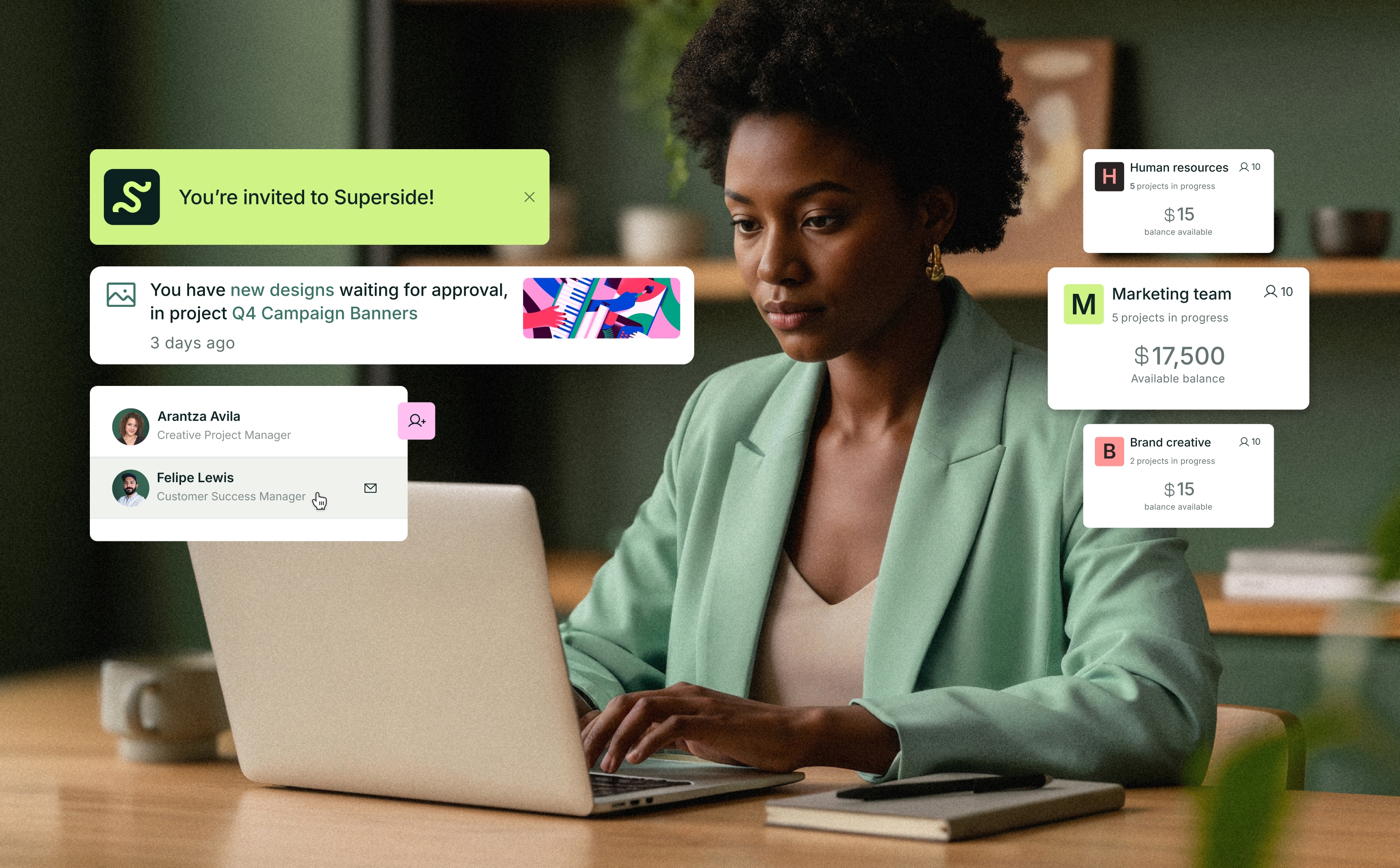
Learn from Kirsten van Rooyen, Superside's Head of Video Strategy, about what it takes to craft a winning video marketing strategy in 2023. From understanding your audience and how they interact with platforms to auditing your video efforts and breaking out of old habits, van Rooyen shares her top tips based on decades of experience.
I'm not sure if MTV knew they were creating a video marketing strategy (and predicting the future) when they chose the first video to air on August 1, 1981.
The video, Video Killed The Radio Star by The Buggles, helped launch a revolution that altered how audiences consumed music. Since then, video has gone on from changing how we discover music to forever altering the way businesses engage with audiences.
Today, video dominates how audiences spend their time online for everything from entertainment and socializing to education and search.
Video technology isn’t standing still, either. YouTube, Meta, TikTok and other video platforms are constantly adding innovative new features, from artificial intelligence to enhanced recommendations and editing tools to make it simple for creators to craft the next viral clip.
So, how can you keep up? And what should you consider when crafting a video marketing strategy in 2023? I asked Superside's Head of Video Strategy, Kirsten van Rooyen, to help shed some light on these questions.
How to Create a Video Marketing Strategy
We all know video isn’t a nice to have for brands anymore—it’s a must-have component of every content strategy.
But before you start storyboarding or scouting for locations, you need to understand who your audience is, where they consume video and your video goals. Yes, I'm talking about a video marketing strategy! But van Rooyen is the expert here, so let's dive right into her advice.
Tip #1: Always start with the audience
You've heard it a million times: Know your audience. But it bears repeating in relation to video. Before reviewing platforms and spitballing ideas, van Rooyen emphasizes that a video marketing strategy needs to start with your audience.
When considering your video marketing content strategy from the audience perspective, she says to look at two things—who they are beyond demographics and what they really want from your brand (not what you want to serve them!).
Looking at those two things, you can draw enough insights out to get something creative going. Something that makes you look and think about things differently and helps you start to unpack a strategic approach.

Tip #2: Understand how audiences interact with platforms
It can often seem like it’s a TikTok world, and we’re all just living in it. From YouTube Shorts to Instagram Reels, platforms are constantly playing catch up. But even though the features might seem the same, a one-size-fits-all approach for video platforms isn’t the right way to go when creating your social media video marketing strategy.
If you’re not meeting the audience where they are, it becomes really forgettable content versus content that the audience wants to sit a while with—which is what you want.

One of the biggest mistakes brands make is taking content created for TikTok and reposting it to YouTube Shorts and Instagram Reels. Just because it's a vertical video, doesn’t mean the content will connect the same across each platform’s audience.
This is also why brands miss the mark on TikTok. Instead of aligning with the way people are using the platform, they try to create content that will work on all the other platforms, too. In the case of TikTok, van Rooyen says it's mostly a Gen Z platform and they're using it as a search tool, similar to how older audiences would use YouTube or Google to find answers to things.
For a primer on using TikTok as a business, check out this video:
Tip #3: Audit your current video efforts (and your competitors')
Before you can figure out where you’re going, it’s important to know where you’ve been. If you’ve been creating videos for a while, your audience and the platforms you use have likely evolved.
That's why van Rooyen's next tip is to audit your current video efforts. She says that while it can seem daunting, an audit is critical to understanding how your videos are working and where there are opportunities to connect deeper with your audience.
Start with your vanity metrics—views and likes—and then take it a step further. Say, a particular video has a lot more views. What's the reason this one was performing so well? When you watch it a few times, you realize it was the bumper ad, and then you can make a note and move on to the next video.

It’s not always possible to get data on what your competitors are doing, but you can still gain insights by looking at their videos' public performance. Though you shouldn't copy your competitors blindly, van Rooyen recommends looking at what they're doing and what’s engaging their audience to spot untapped opportunities for your brand.
Tip #4: Creators and influencers aren’t the same thing
Owned channels are critical to your video marketing strategy—but they're not your only channels. Partnerships are a tried and true part of video marketing, but van Rooyen wants you to remember creators and influencers are two very different types of partners. She defines using an influencer as a media purchase where you're buying space on their feed.
As she explains, influencers have great visibility and reach because that's what they're all about. They're great at building their own brand.
So, while influencers can help your reach, she says working with content creators can be a better way to connect with audiences more authentically. One way is to work with content creators who aren’t celebrities to provide a real-world review of a product that you can put out as an ad. This type of UGC-style content comes off as more authentic in your audience's social feed.
You can go further and partner with influential content creators like MKBHD to do the same thing. But they're still content creators over influencers. They're excellent at making content to engage their audience, not building a brand that makes them successful.

Tip #5: Break out of old habits with your video content strategy
When she's helping clients develop their video content strategies, van Rooyen looks at how others are telling stories in the same space. Which stories and formats get the most engagement and traction? You should always be looking for new opportunities as a brand instead of sticking to old habits, van Rooyen explains.
If you feel like your brand needs to be on TikTok, van Rooyen suggests following the 70-20-10 rule to develop a strategy that gets results and allows you to explore how to interact with your audience. The 70-20-10 rule gives your strategy a playground to test with, while still using the channels you know work.
70% of what you do should be what you know works. 20% should be what you think is going to work. And 10% should be your playground. That can be where we play as a brand to see maybe there's a different way we can reach an audience, maybe a different way we can tell a story.

Tip #6: SEO is only part of a video marketing strategy
Driving YouTube video views depends on SEO search terms, thumbnails and social hooks. With TikTok, the discovery process is more fluid and driven by the platform’s algorithm.
You have to be brave. You don’t have to approach it drastically differently, but you do have to approach it differently. You have to look at your caption as part of what's getting somebody there rather than an SEO-optimized search query through Google. Google has been around for so long, as marketers, we’re used to optimizing to drive SEO in that way. But new audiences in that space are using TikTik for discovering things.

This doesn’t mean SEO doesn’t need to be part of your video marketing strategy in the TikTok era. For example, van Rooyen has a client with over 1,000 explainer videos on their YouTube channel. This client's entire purpose is to drive SEO.
Since they want to rank first every time somebody searches, they're not as concerned about view counts for each individual video. Even if a video only has two views, it's doing its job. And the brand is getting recognized when somebody is searching for their terms, which was their objective. So, just make sure you understand the objective behind each video, van Rooyen urges.
Of course, video can and should support your SEO strategy. Here's how:
Tip #7: Distribute your videos with purpose
Understanding where each channel fits in your funnel is crucial to your video marketing strategy. As van Rooyen explains, you need to be conscious of what each channel can drive for your business when crafting your strategy and distributing your videos.
Facebook and YouTube usually have big audiences, so you'll always use those as your reach drivers to feed the top of the funnel. Instagram is the place where beautiful stories should be told. I wouldn't recommend you put your discounted furniture on Instagram with the price and product. But if you show someone how beautiful the furniture could look in their lifestyle, and then happened to guide them later on through an ad saying it's on sale, then that's an interesting way to tell the brand story.

When measuring success, van Rooyen says to remember content metrics must align with business goals. One of the worst things that can happen is your manager coming to you saying, "We're not getting the sales we need," even though your latest video is trending on TikTok with a million views a minute.
Your team needs to understand what content is there to feed the top of the funnel and what's there to rank well on Google and drive better conversions. These two pieces of data don't talk to each other. If your goal is to get signups or sell your product, yet you're focusing all your resources on top of funnel videos that get views and engagement instead, then you likely need to take a step back and redistribute your approach.
Be Smart With Your Video Marketing Strategy
While your video marketing strategy will be unique to your audience, channels and business goals, van Rooyen says every successful strategy shares a common tactic—smart video production.
It doesn’t matter what channel you’re creating a video for. Shoot your content once and do it well so you can cut it up and use it lots of different times to give it more longevity. To me, that is the number one thing, to be effective as a marketer, you've got to get your budget to stretch as far as you can.

Another way to be smart with your video production? Get help from a video marketing agency partner, like Superside, and tap into insights from experts like Kirsten for yourself!














